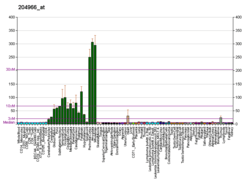Brain-specific angiogenesis inhibitor 2
Brain-specific angiogenesis inhibitor 2 is a protein that in humans is encoded by the BAI2 gene.[5][6] It is a member of the adhesion-GPCR family of receptors.[7]
BAI1, a p53-target gene, encodes brain-specific angiogenesis inhibitor, a seven-span transmembrane protein and is thought to be a member of the secretin receptor family. Brain-specific angiogenesis proteins BAI2 and BAI3 are similar to BAI1 in structure, have similar tissue specificities and may also play a role in angiogenesis.[6]
References
- GRCh38: Ensembl release 89: ENSG00000121753 - Ensembl, May 2017
- GRCm38: Ensembl release 89: ENSMUSG00000028782 - Ensembl, May 2017
- "Human PubMed Reference:". National Center for Biotechnology Information, U.S. National Library of Medicine.
- "Mouse PubMed Reference:". National Center for Biotechnology Information, U.S. National Library of Medicine.
- Shiratsuchi T, Nishimori H, Ichise H, Nakamura Y, Tokino T (Apr 1998). "Cloning and characterization of BAI2 and BAI3, novel genes homologous to brain-specific angiogenesis inhibitor 1 (BAI1)". Cytogenet Cell Genet. 79 (1–2): 103–8. doi:10.1159/000134693. PMID 9533023.
- "Entrez Gene: BAI2 brain-specific angiogenesis inhibitor 2".
- Stacey, edited by Simon Yona, Martin (2010). Adhesion-GPCRs : structure to function. New York: Springer Science+Business Media. ISBN 9781441979124.CS1 maint: extra text: authors list (link)
External links
- Human ADGRB2 genome location and ADGRB2 gene details page in the UCSC Genome Browser.
Further reading
- Kreienkamp HJ, Zitzer H, Gundelfinger ED, et al. (2000). "The calcium-independent receptor for alpha-latrotoxin from human and rodent brains interacts with members of the ProSAP/SSTRIP/Shank family of multidomain proteins". J. Biol. Chem. 275 (42): 32387–90. doi:10.1074/jbc.C000490200. PMID 10964907.
- Kee HJ, Koh JT, Kim MY, et al. (2002). "Expression of brain-specific angiogenesis inhibitor 2 (BAI2) in normal and ischemic brain: involvement of BAI2 in the ischemia-induced brain angiogenesis". J. Cereb. Blood Flow Metab. 22 (9): 1054–67. doi:10.1097/00004647-200209000-00003. PMID 12218411.
- Petersen HH, Hilpert J, Militz D, et al. (2003). "Functional interaction of megalin with the megalinbinding protein (MegBP), a novel tetratrico peptide repeat-containing adaptor molecule". J. Cell Sci. 116 (Pt 3): 453–61. doi:10.1242/jcs.00243. PMID 12508107.
- Adkins JN, Varnum SM, Auberry KJ, et al. (2003). "Toward a human blood serum proteome: analysis by multidimensional separation coupled with mass spectrometry". Mol. Cell. Proteomics. 1 (12): 947–55. doi:10.1074/mcp.M200066-MCP200. PMID 12543931.
- Nagaraja GM, Kandpal RP (2004). "Chromosome 13q12 encoded Rho GTPase activating protein suppresses growth of breast carcinoma cells, and yeast two-hybrid screen shows its interaction with several proteins". Biochem. Biophys. Res. Commun. 313 (3): 654–65. doi:10.1016/j.bbrc.2003.12.001. PMID 14697242.
- Ota T, Suzuki Y, Nishikawa T, et al. (2004). "Complete sequencing and characterization of 21,243 full-length human cDNAs". Nat. Genet. 36 (1): 40–5. doi:10.1038/ng1285. PMID 14702039.
- Bjarnadóttir TK, Fredriksson R, Höglund PJ, et al. (2005). "The human and mouse repertoire of the adhesion family of G-protein-coupled receptors". Genomics. 84 (1): 23–33. doi:10.1016/j.ygeno.2003.12.004. PMID 15203201.
This article incorporates text from the United States National Library of Medicine, which is in the public domain.
This article is issued from Wikipedia. The text is licensed under Creative Commons - Attribution - Sharealike. Additional terms may apply for the media files.




